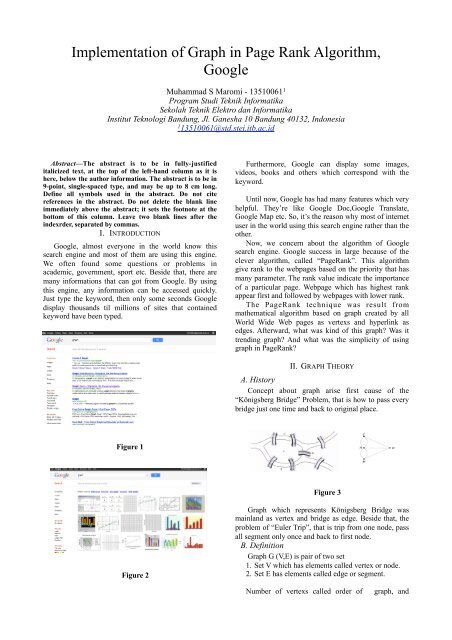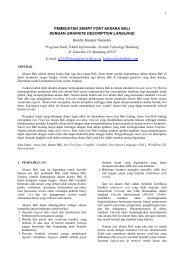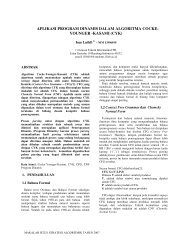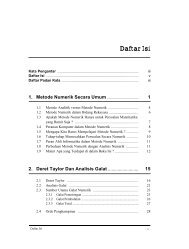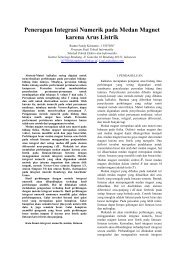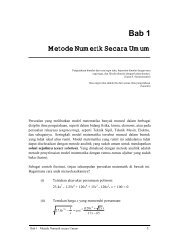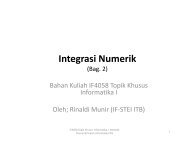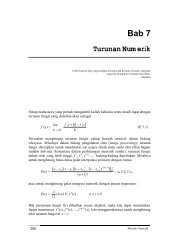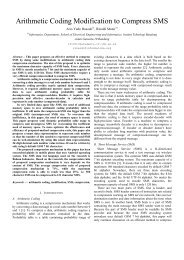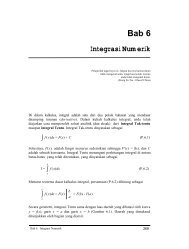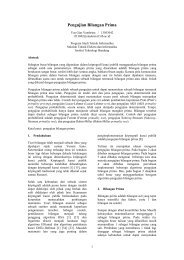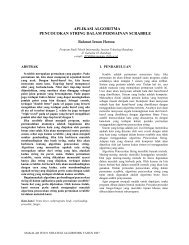makalah google - ITB
makalah google - ITB
makalah google - ITB
Create successful ePaper yourself
Turn your PDF publications into a flip-book with our unique Google optimized e-Paper software.
Implementation of Graph in Page Rank Algorithm,<br />
Google<br />
Muhammad S Maromi - 13510061 1<br />
Program Studi Teknik Informatika<br />
Sekolah Teknik Elektro dan Informatika<br />
Institut Teknologi Bandung, Jl. Ganesha 10 Bandung 40132, Indonesia<br />
1 13510061@std.stei.itb.ac.id<br />
Abstract—The abstract is to be in fully-justified<br />
italicized text, at the top of the left-hand column as it is<br />
here, below the author information. The abstract is to be in<br />
9-point, single-spaced type, and may be up to 8 cm long.<br />
Define all symbols used in the abstract. Do not cite<br />
references in the abstract. Do not delete the blank line<br />
immediately above the abstract; it sets the footnote at the<br />
bottom of this column. Leave two blank lines after the<br />
indexrder, separated by commas.<br />
I. INTRODUCTION<br />
Google, almost everyone in the world know this<br />
search engine and most of them are using this engine.<br />
We often found some questions or problems in<br />
academic, government, sport etc. Beside that, there are<br />
many informations that can got from Google. By using<br />
this engine, any information can be accessed quickly.<br />
Just type the keyword, then only some seconds Google<br />
display thousands til millions of sites that contained<br />
keyword have been typed.<br />
Figure 1<br />
Figure 2<br />
Furthermore, Google can display some images,<br />
videos, books and others which correspond with the<br />
keyword.<br />
Until now, Google has had many features which very<br />
helpful. They’re like Google Doc,Google Translate,<br />
Google Map etc. So, it’s the reason why most of internet<br />
user in the world using this search engine rather than the<br />
other.<br />
Now, we concern about the algorithm of Google<br />
search engine. Google success in large because of the<br />
clever algorithm, called “PageRank”. This algorithm<br />
give rank to the webpages based on the priority that has<br />
many parameter. The rank value indicate the importance<br />
of a particular page. Webpage which has highest rank<br />
appear first and followed by webpages with lower rank.<br />
The PageRank technique was result from<br />
mathematical algorithm based on graph created by all<br />
World Wide Web pages as vertexs and hyperlink as<br />
edges. Afterward, what was kind of this graph? Was it<br />
trending graph? And what was the simplicity of using<br />
graph in PageRank?<br />
II. GRAPH THEORY<br />
A. History<br />
Concept about graph arise first cause of the<br />
“Königsberg Bridge” Problem, that is how to pass every<br />
bridge just one time and back to original place.<br />
Figure 3<br />
Graph which represents Königsberg Bridge was<br />
mainland as vertex and bridge as edge. Beside that, the<br />
problem of “Euler Trip”, that is trip from one node, pass<br />
all segment only once and back to first node.<br />
B. Definition<br />
Graph G (V,E) is pair of two set<br />
1. Set V which has elements called vertex or node.<br />
2. Set E has elements called edge or segment.<br />
Number of vertexs called order of graph, and
number of edges called size of graph.<br />
Figure 4<br />
Bellow the description of figure 4<br />
Graph G1<br />
V = {1,2,3,4}<br />
E = {(1,2),(1,3),(2,3),(2,4),(3,4)}<br />
Graph G2<br />
V = {1,2,3,4}<br />
E = {(1,2),(1,3),(1,3),(2,3),(2,4),(3,4),(3,4)}<br />
= {e1, e2, e3, e4, e5, e6, e7}<br />
Graph G3<br />
V = {1,2,3,4}<br />
E = {(1,2),(1,3),(1,3),(2,3),(2,4),(3,4),(3,4),(3,3)}<br />
= {e1, e2, e3, e4, e5, e6, e7, e8}<br />
At G2, side e3 and e4 named by paralel edges,<br />
because both sides connect two same nodes, viz node 1<br />
and node 4.<br />
At G3, side e8 named by self-loop because begin and<br />
end in same node.<br />
B. Definition<br />
There are three ways to classification kind of graph<br />
1. Presence of paralel edge or self-loop<br />
a. Simple graph<br />
Graph which doesn’t have paralel edge.<br />
b. Multigraph<br />
Graph which have paralel edge.<br />
2. Number of node<br />
a. Limited graph<br />
Graph which have n nodes and limited<br />
b. Unlimited graph<br />
Graph which have so many n node, unlimited<br />
3. Number of node<br />
a. Directed graph<br />
Graph which sides have orientation.<br />
b. Undirected graph<br />
Graph which sides doesn’t have orientation.<br />
Figure 5<br />
C. Terminology of Graph<br />
1. Subgraph and Complement Subgraph<br />
For example G = (V,E) is a graph. G1 = (V1,E1) is<br />
subgraph from G if V1 ⊆ V and E1 ⊆ E.<br />
Complement from subgraph G1 toward graph G<br />
is graph G2 such that E2 = E - E1 and V2 is set of<br />
nodes that connect all sides of G2.<br />
Figure 6. Graph G(left), G1(middle), G3(right)<br />
2. Spanning Subgraph<br />
If E’ contained all segments in E which both tip<br />
in V’, then G’ is subgraph that formed by V’.<br />
Figure 7.<br />
3. Degree<br />
Degree is number of segments that connect node.<br />
Figure 8. Graph G(left), G1(middle), G3(right)<br />
Graph G1 : d(1) = d(2) = 2<br />
d(2) = d(3) = 3<br />
Graph G2 : d(1)=3<br />
(side with multiple segment)<br />
d(3) = 4<br />
(side with self loop)<br />
Graph G3 : d(5) = 0 (isolated node)<br />
d(4) = 1 (last node)<br />
4. Adjacency<br />
Two nodes adjacent if both of them direct<br />
connected. See figure 8.<br />
graph G1 : node 1 adjacents with node 2 and 3,<br />
node 1 not adjacents with node 4.
5. Incidence<br />
For any segment e = (vj,vk) called :<br />
e side with node vj or<br />
e side with node vk<br />
See figure 8.<br />
Graph G1 :<br />
segment (2,3) side with node 2 and node 3<br />
segment (2,4) side with node 2 and node 4<br />
but side (1,2) not side with node 4<br />
6. Isolated Node<br />
Isolated node is node there is no node that side<br />
with. For example node node 5 in graph G3 (see<br />
figure 8).<br />
7. Null Graph<br />
Graph which set of side is Null Set.<br />
Figure 9.<br />
C. Operation of Graph<br />
G1 = (E1,V1) , G2 = (E2,V2)<br />
1. Union G1 ∪ G2 is graph with set of segments E1 ∪<br />
E2<br />
2. Incision G1 ∩ G2 is graph with set of segments E1<br />
!"#"$�%&'<br />
∩ E2<br />
3. Difference G1 - G2 is graph with set of segments<br />
E1 - E2<br />
!"#"$%"&&'$()*+,-./$01(<br />
4. Ring addition G1 ⊕ G2 is graph with set of<br />
Figure 12. Deletion of segment e3<br />
!"#"$%"&'$()*+,-.$/0'%'1'*0#"$/*'23404.#23105'$/0%.*363$/&'$0+1"*070,3'4<br />
segments (E1 ∪ E2) - (E1 ∩ E2)<br />
84.#23106",%",'9'-07:;01'130#"$/*363$/&'$0-.-.&+$-+*0?0<br />
Figure 10<br />
(<br />
D. Decomposition<br />
Graph is called decomposed into K and L if G = K<br />
∪ L and K ∩ L = ∅. Example:<br />
E. Deletion<br />
1. Node Deletion<br />
Notation is G - {V}<br />
2. Segment Deletion<br />
Figure 11<br />
Figure 12. Deletion of node v2<br />
Notation is G - {e}<br />
Figure 13. Shorting toward node A & C<br />
&"."-+232$0'$(<br />
G. Correlation<br />
� !456787979():78;1( 1. Walk<br />
Walk in graph is line of nodes and flit segments<br />
!",9'1'$'$0 '-'30 @'1&0 2'%'0 v1, e1, 43'-30 v2, e2,...., A,'B0 A0 '%'1'*0 en-1,vn→ei connect 6',.4'$0 vi and 4.#2310 %'$0 ,3'40 6"<br />
vi+1<br />
/'$-.0<br />
wrote only line of segments or line of nodes.<br />
0 CD;0"D;0C7;0"7;0E;"$
In this, v1 is called first node and vn is called last<br />
node. Close Walk happen if v1 = vn and Open<br />
Walk if connect v1 and vn. Length of walk is<br />
number of segment line.<br />
2. Trail<br />
Trail is walk which all segments in that line are<br />
different.<br />
3. Path<br />
Path is Walk which all node in that line are<br />
different.<br />
4. (Circuit) Cycle<br />
Cycle is Trail which begin and end at the same<br />
#'(%)*+#,%-.'(#'+/'(%0*",/*)%+*0.1/)%!"#"$%"&'<br />
node. Length of cycle is number of segment.<br />
Graph that doesn’t include circuit called acyclic.<br />
4%5%%<br />
!"#"$�%&'$(�)$"*�<br />
A C<br />
B<br />
Figure 15.<br />
Solve the equation above and get the PageRank values<br />
PR(A) = 14/13<br />
PR(B) = 10/13<br />
PR(C) = 15/13<br />
The example above is too easy compare to the real<br />
hyperlinks and billions of webpages registered. But, it ‘s<br />
helpful enough to make sense the whole algorithm of<br />
search engine, Google. Although it’s not easy in practice.<br />
(%)%*+,-."$%$-'/"."0&%6*,#%/')/,%0.)*#7%0*-7/8%+#"*%("#$%)."+#7#)%6#8/"%&#'(%<br />
Figure 14.<br />
IV. IMPLEMENTATION OF GRAPH<br />
/'(,#'%,.+/#%0*-7/8%)."0.1/)9%%<br />
III. PAGE RANK<br />
."4/1/'(% 0/#)/% ("#$% +*0.1/)% 123420-0% *#'+% )%1*8#%0/1("#$%)."0.1/)%)*+#,%<br />
Internet networks in the world were very large. The<br />
The theory of graph already explained above, now millions of websites and billions of webpage be a trouble<br />
(%+#8#-%0/1("#$%)."4/1/'(%8#*'%&#'(%8.1*4%1.0#"9%<br />
turn to explain about the PageRank algorithm itself. The find information that we don’t know exactly the website<br />
original PageRank algorithm was described by address. But, with PageRank algorithm, the whole<br />
Lawrence Page and Sergey Brin. It is given by<br />
internet costumers could easily access information about<br />
news, sport, sains and others.<br />
PR(A) = (1-d) + d (PR(T1)/C(T1) +....+PR(Tn)/C(Tn)) Further, the PageRank algorithm itself was still<br />
difficult to describe cause of the lot of webpages and<br />
where<br />
hyperlinks. So, concept graph is going to helpful to<br />
• PR(A) is the PageRank of page A<br />
describe whole webpages and hyperlinks to be a giant<br />
• PR(Ti) is the PageRank of pages Ti which link set of vertex and edge.<br />
to page A<br />
• C(Ti) is the number of outbond links on page<br />
Ti<br />
• d is damping factor which can be set between<br />
0 and 1<br />
%<br />
So, first of all, we see that PageRank doesn’t rank<br />
&.&#&/&0& website a whole, but it rank every page individually.<br />
Further, the PageRank of page A is recursively defined<br />
-&.&6&/&+#&/&*-& by PageRanks of those pages which link to page A. The<br />
PageRank of pages Ti doesn’t influence Pagerank of<br />
page A uniformly. Because the PageRank og page Ti has<br />
'%5%%5%1#'&#,'&#%,3-73'.'%("#$%!%<br />
the benefit from another page linking to page A is<br />
reduced.<br />
)8)&9&:4;8)?&,%#+#8#4%7#'6#'(%6#8/"%)."7.'+.,%#')#"#%,.%?%0*-7/8%<br />
The characteristic of PageRank shal illustrated by a<br />
Figure 16<br />
small example. Assume there are small pages A, B and C<br />
where page A links to page b and C, page B links to page In search algorithm necessary to link as quick as<br />
&:2)$2&>8)?&$68%2A2#>&,%#+#8#4%-#,0*-/-%6#"#,%#')#"#%0*-7/8%!9%% C and page C links to page A. Then assume the damping possible. %% In graph % theory, there is algorithm to find the<br />
factor d to 0.5. So, we get below PageRank equation: simple way to a particular node, also if the the graph was<br />
weighted. It’s same to the form of webpages in world<br />
PR(A) = 0.5 + 0.5 PR(C)<br />
wide web. The weight of webpage is correspond to<br />
PR(B) = 0.5 + 0.5 (PR(A) / 2)<br />
PageRank. And the edge of direct graph correspond to<br />
PR(C) = 0.5 + 0.5 (PR(A) / 2 + PR(B))<br />
webpage that link to othe page.<br />
/�01,'$(23"�4�56/(�!7(�0#262(8�9%� ::�<br />
�<br />
'
V. CONCLUSION<br />
1. Google use PageRank algorithm to simply the<br />
search of particular webpage based on the<br />
keyword typed<br />
2. The PageRank algorithm itself was simply<br />
described to using graph concept<br />
REFERENCES<br />
[1] Army N, The Science of Search Engine Rangkings (Book style).<br />
Proceton University Press. June 22, 2009. Ch 4<br />
[2] http://en.wikipedia.org/wiki/Google_Search, on December 11 ,<br />
2011<br />
[3] http://en.wikipedia.org/wiki/PageRank on December 11, 2011


